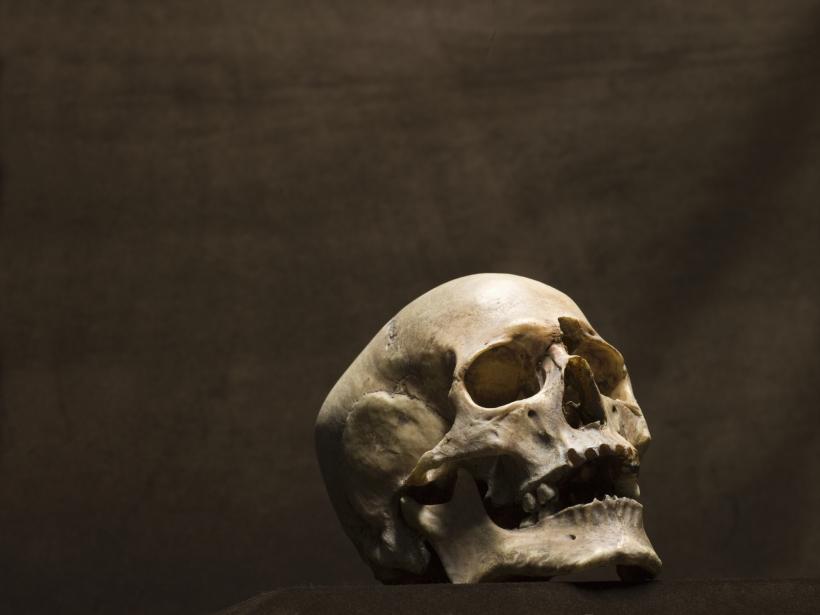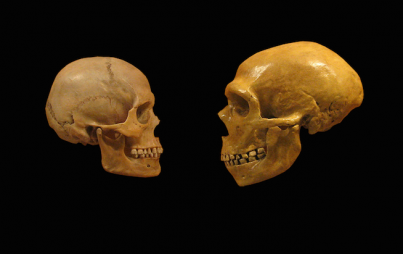
No one really knows exactly from whence Native Americans came. But a new paper based on a recent archeological finding provides a novel theory on the origins of Native Americans, as well as a dramatic argument for why Native Americans of the past few thousand years look so different from the Paleoamericans that first inhabited the New World. It starts off interesting, and perhaps plausible but perhaps absurd. And then the head author goes off the deep end ... but I’m getting ahead of myself.
In 2007 several divers in Mexico stumbled across an underwater cave on the Yucatan Peninsula, where they discovered “a small cranium lying upside down with a perfect set of teeth and dark eye sockets looking back at us,” as one of the divers explained. Ribs and a broken pelvis lay nearby, later determined by archeologists to be those of a teenaged girl who died 12,000 years ago—making them the oldest known remains of a New World inhabitant. Now entirely flooded, when the girl—nicknamed “Naia” after a mythical Greek water nymph—was alive, the cave network would have been mostly dry. Commentators conjecture she wandered into the dark cave, couldn’t see an enormous pit in front of her and fell to her untimely death.
When researchers did the standard DNA tests on Naia’s remains to find out whatever genetic goodies possible, they discovered that she had a genetic marker common across modern Native Americans. Scientists think this marker evolved in a prehistoric population isolated on a now-submerged land mass between Alaska and Siberia dubbed "Beringia." Rebuffing the mainstream idea that the Paleoamericans and later groups came from separate populations and migrations, the Naia team conjectures they are the same people, all descended from Beringia.
Here’s the thing: Academics generally hold that Paleoamerican remains like Naia and the famous 9,000 year-old “Kennewick Man” have facial features more like certain Pacific Islanders, based on their projecting faces, wide-set eyes and prominent foreheads. Later Native Americans have tended to have broader, flatter faces and rounder skulls. Why the discrepancy, if they have the same ancestry as the Naia team argues? Bold claim alert: The authors believe that a period of rapid evolutionary change occurred within the Paleoamericans which altered their appearance.
Since its recent publication, the paper has had plenty of skeptics. One forensic anthropologist at the Smithsonian reiterated that rapid change in appearance typically suggests multiple migrations of people, and cautioned that the DNA and resulting conjectures are based on “a sample of one.” Similarly, a Vanderbilt anthropologist voiced leeriness of the researchers' conclusions, saying the finding “doesn’t mean that all early skeletons from the Americas represent the same story.”
The cautioning academics are clearly correct that more evidence would be necessary to give full credence to the single population, rapid evolution theory. It’s also worth keeping in mind that anthropologists sometimes try to force interpretation of physical features into groupings that may not be accurate. After all, the supposedly distinctly paleo-looking Kennewick man also bears an uncanny resemblance to actor Patrick Stewart, who is no doubt super Anglo genetically, and who could probably also pass as a modern Native American with some bronzer. So as far as I can tell, populations may not actually look super distinct.
One of the authors of the paper also falls victim to the principle vice of biological anthropologists with a follow-up argument that attempts to divine the Paleoamericans’ social behavior based on Naia’s DNA. You see, to the chagrin of their socio-cultural peers, biological anthropologists like to pretend that human behavior all comes down to our hardwiring (you know, women are inherently hysterical nurturers, men are naturally rational robots, and the like), and that culture is a negligible factor. Eugenics much?
Here it goes: The paper’s principle author, James Chatters (an “independent researcher” apparently not affiliated with a university or institution), lays out a theory that early Paleoamericans were a “Human Wild Style” (?) population.
Yep, these early migrants were aggressive “risk-takers and novelty-seekers” who chased wild game all the live long day. But as their descendants settled down into semi-agricultural lifestyles, natural selection started favoring pansies with “softer, more feminine features.” (Delve into the works of many biological anthropologists and you’ll find they hold little esteem for women).
Here’s the real gem: Chatters conjectures that Naia may have ventured into the dark and mysterious cave because she was a pre-pansy risk-taker who left caution to the wind because her mitochondrial DNA just didn’t give a rat’s ass.
Gag. There is literally no way to know what personality type the girl had based on finding her remains in a cave. And even if she and her people were, to use Chatter’s strange phrase, “Wild Style,” it’s much more likely to be based on their historic societal subsistence behaviors, rather than cranial predestination. They aren’t obsessed with football in the South because of some Confederate gene for violence—it’s just a fucking tradition. But whatev. The discovery is still cool (crosses arms and shrugs), even if some of the interpretations seem way off.
Image: Thinkstock






